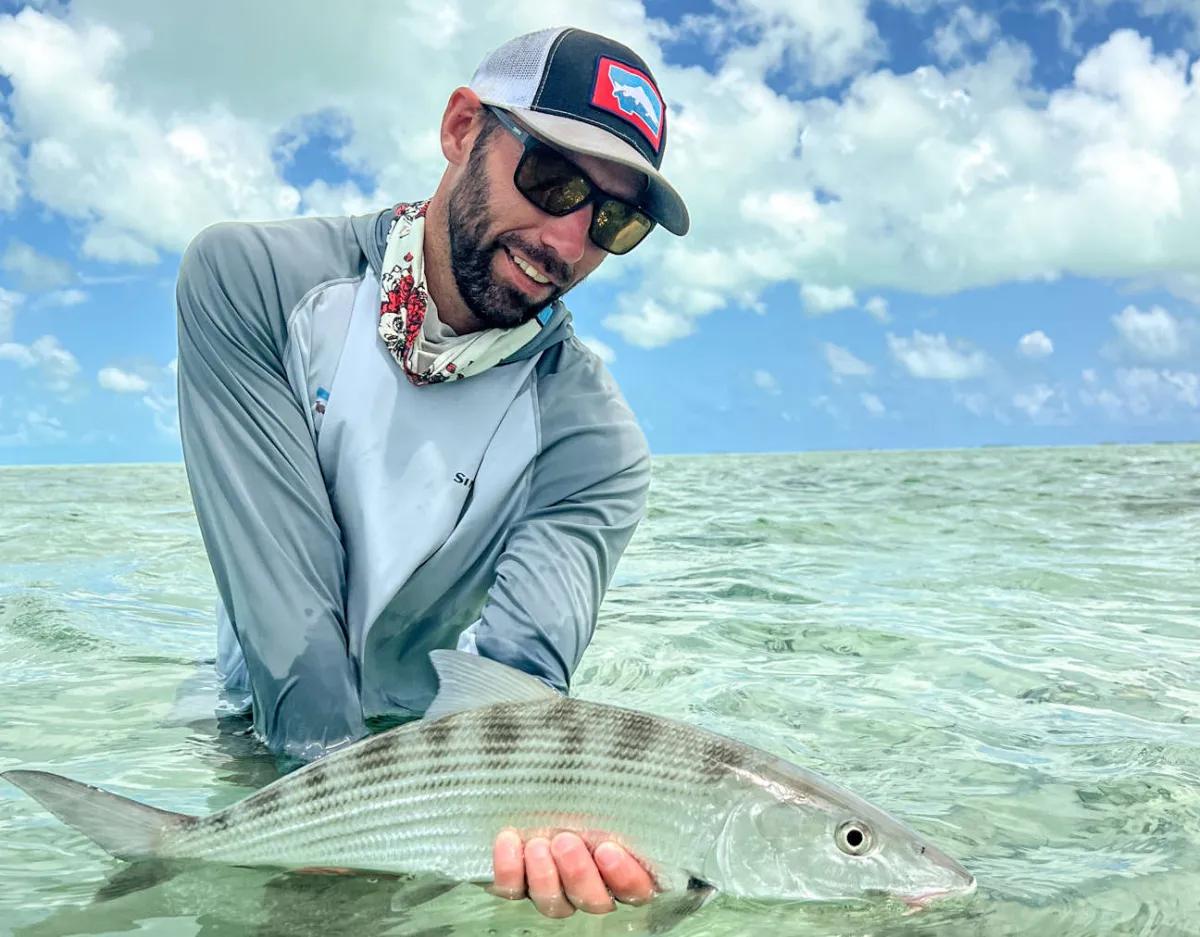
“Bonefish rod!” “Tarpon rod!” “Permit rod!” When hollered by a seasoned saltwater flats guide atop a polling platform, these simple two-word phrases are enough to make even the most experienced saltwater angler’s head spin and knees go a bit weak. I experienced all these regularly on our recent hosted trip to Cuba while experiencing some of the world’s premier mixed-species flats with an outstanding group of Montana Angler guests. Our home for the week was a live-aboard mothership custom-designed for anglers and excellent amenities.
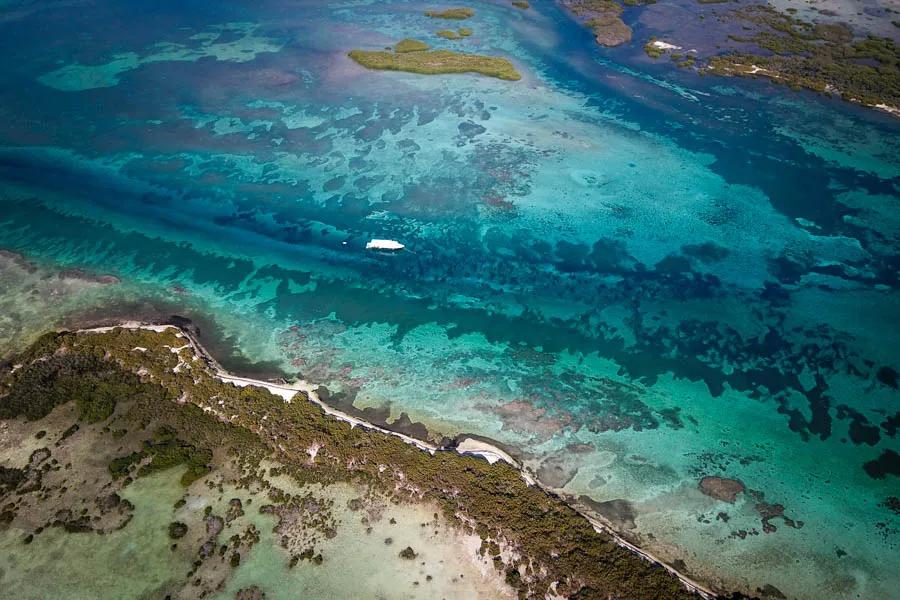
Cuba: A Unique Saltwater Destination
The vast white sand beaches of Cayo Largo are located in the Canarreos Archipelago off Cuba’s southern coast. This pristine area is only about 300 miles from Miami as the crow flies, yet it feels like a different world entirely. Absent are the busy marinas, plethora of outfitters, casual tourists, spring breakers, and general anxieties that accompany the high volume of traffic that frequent many domestic saltwater fishing locations. Because Cuba is such a unique destination with specific travel requirements, choosing a Montana Angler Hosted Trip is a good way to ensure a smooth trip. In fact, we've already book a week in February of 2026 for another Montana Angler Hosted Trip.
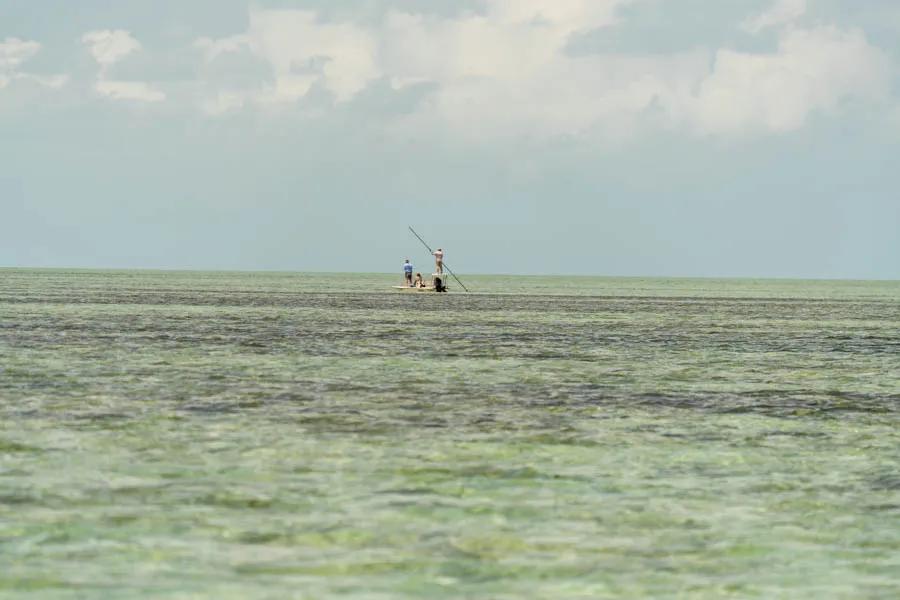
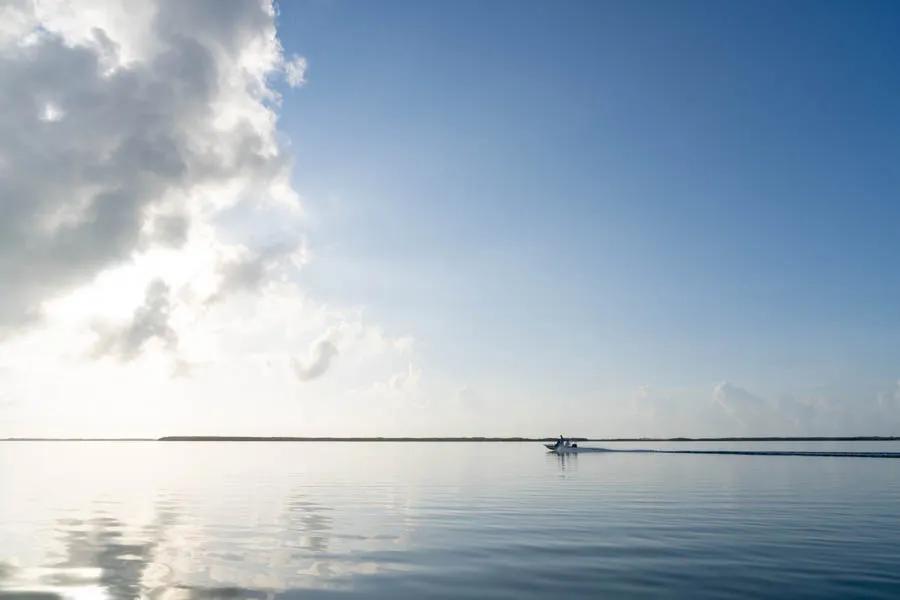
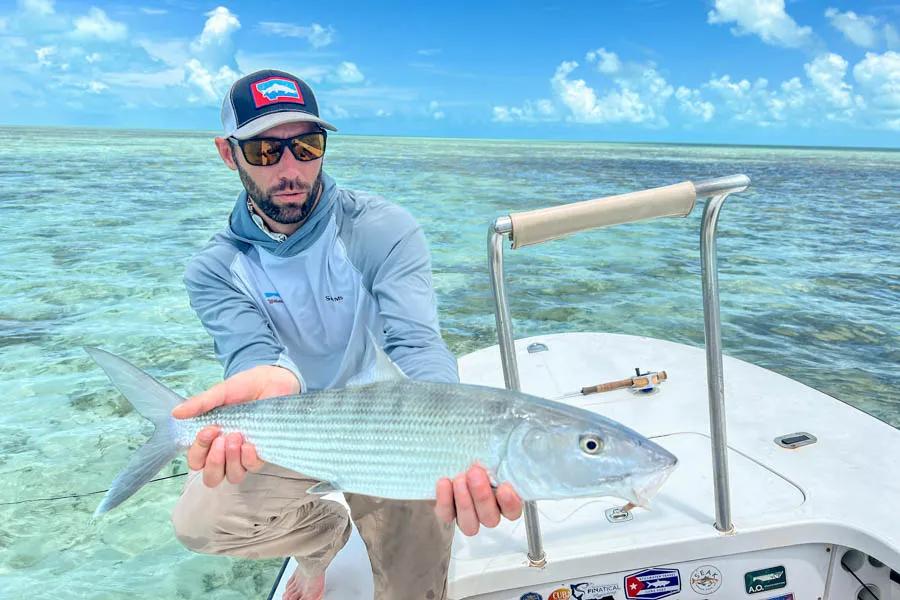
The Cayo Largo area is one of several distinct zones where the mothership operates, all of which have substantial protections and regulations due to their status as marine parks. Here, anglers have the unique opportunity to fish in an exclusive marine park that is void of commercial fisherman and skiffs or yachts from other outfitters. Because our partners at Avalon hold the only commercial permit to operate guided fly fishing in this area, the only skiffs we saw during our week of fishing were those in our group. Over 100 square miles of flats for six skiffs to enjoy exclusive access is nearly unheard of in the current world of saltwater angling. On our hosted fly fishing trips to Cuba, it is still a reality to fish unpressured and carefully managed saltwater flats. Our group of 12 anglers had the opportunity to fish and explore these famed flats from our deluxe accommodations on Avalon’s 110’ JA1 liveaboard yacht.
The Fishing for the Big Three: Bonefish, Permit, Tarpon
Cayo Largo is considered one of the premier destinations on the planet for mixed-species saltwater fly fishing. Permit, bonefish, and tarpon are all present in healthy numbers. Less sought after but equally entertaining species that are abundant are jacks, snapper, barracuda, and snook. With so many species to pursue, there often isn’t a moment when there is something to chase a well presented fly. It cannot be overstated how important having a reliable mixed-species fishing venue can be when fishing conditions present challenges. For example, when fishing in a permit-specific area and a cold front with low pressure and clouds move in, it can be very challenging to find permit on the flats even in an area as remote and well-managed as Cayo Largo.
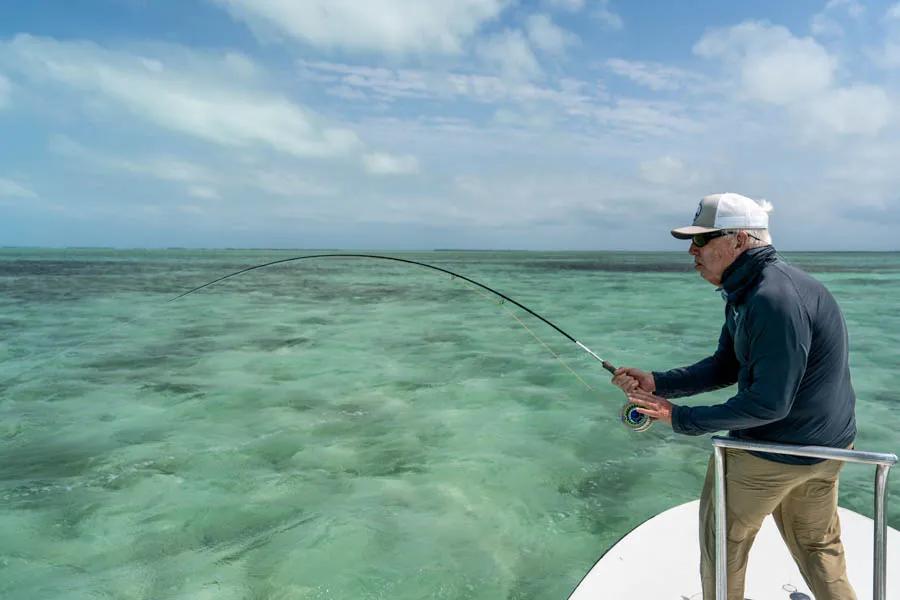
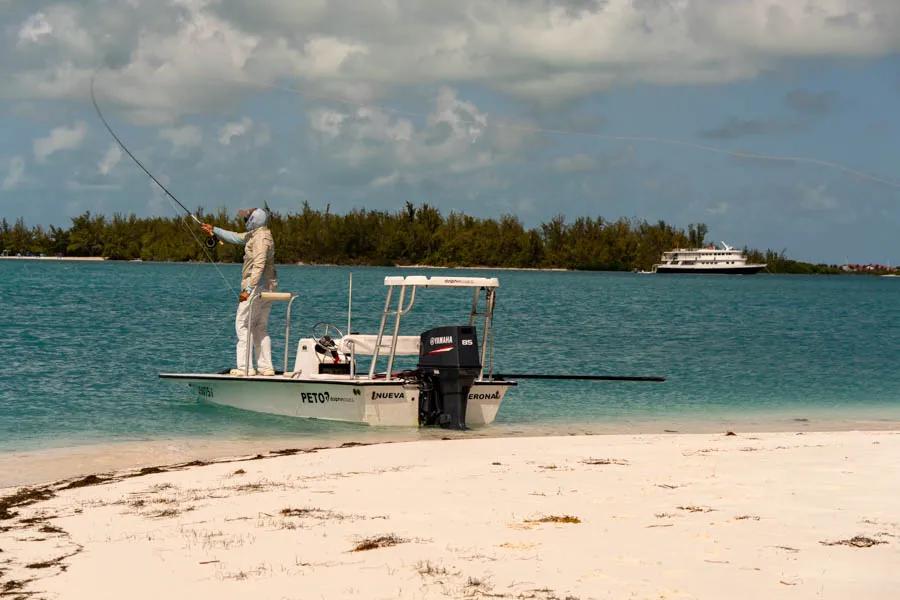
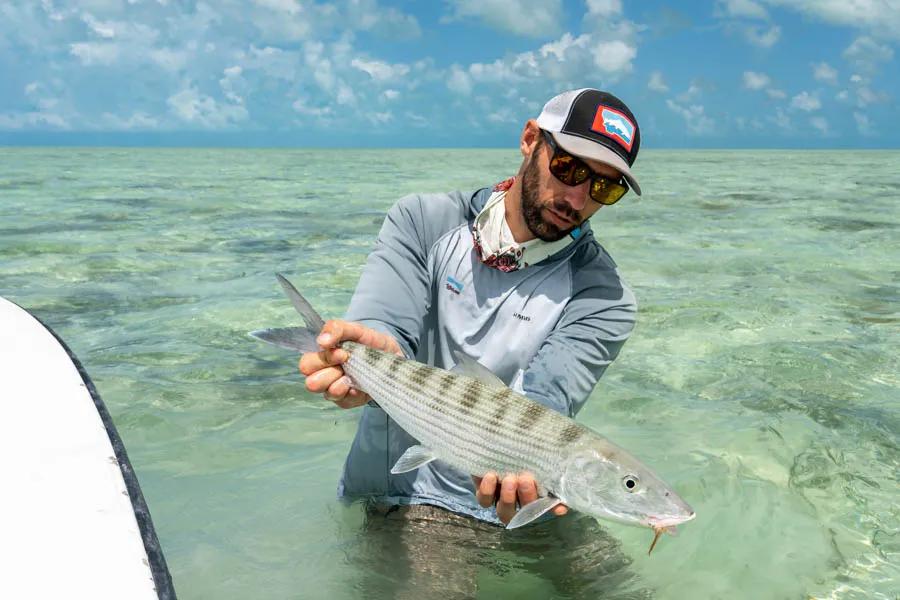
At a location like Cayo Largo, we had this exact scenario of a cold front accompanied by strong north winds and a bit of precipitation move-in mid-trip. Even on the cloudiest, windiest day, our group of anglers were able to find schools of large bonefish to provide some action despite the conditions and desire to cast to the elusive permit.
The mothership-based fishing program runs smoothly. Guide and angler assignments are determined each evening before fishing, giving guests the opportunity to fish with various guides and partners throughout the week. Beverage preferences are gathered in advance and each angler makes their own lunch before breakfast each morning. The making of one’s own lunch proved to be a nice bonus as I was able to choose my meats, condiments, and garnishes just the way I like it–spicy with horseradish mayo. Once breakfast is wrapped up the coolers on each skiff are loaded with beverages and lunches, and the ship’s crew works quickly to get each angler’s gear on the appropriate skiff. I was very impressed with how smoothly and quickly anglers went from eating breakfast to motoring away from the mothership each morning.
Bonefish
The bonefishing around Cayo Largo is phenomenal. The numbers, both in populations and size of fish, rival those found around South Andros in the Bahamas but with a fraction of the angling pressure. The bones are grabby; if you make a half-way decent cast and have the right fly, they will eat it. Hookup rates are incredibly high and refusals are uncommon. Because these fish are so unpressured, they are not leader shy and I never even entertained putting on anything lighter than 16-pound test. Fishing heavier tackle has multiple benefits, especially when the average bonefish is pushing four pounds and fish in the six to eight pound class are commonly encountered.
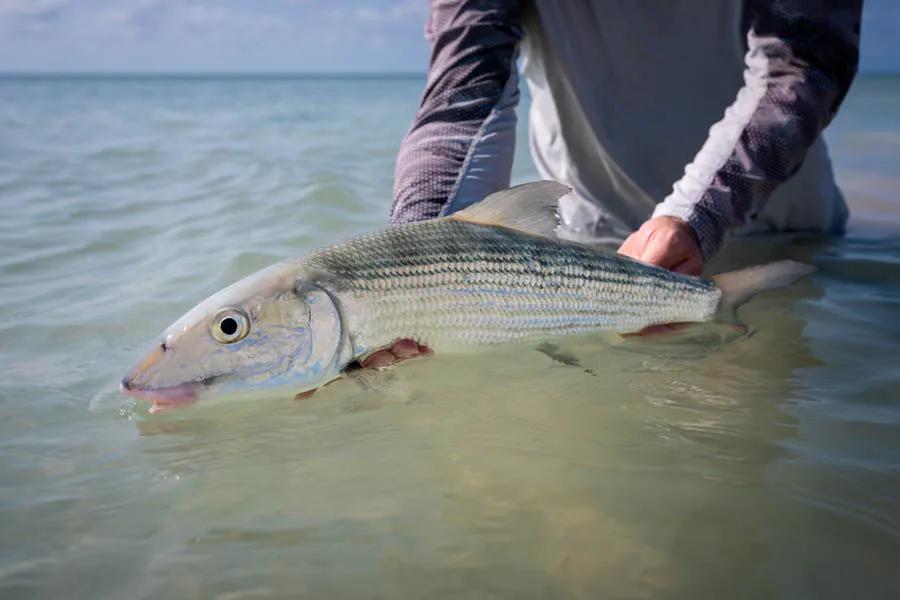
I was able to land several nice bonefish every day of the trip. Sometimes this almost seemed routine and just a prerequisite for completing a grand slam. Other days it was more out of necessity due to weather conditions. There were times when we encountered massive schools numbering in the hundreds and some anglers even witnessed schools of a thousand bonefish or more. The numbers and size of these bonefish schools was a point of friendly debate aboard the yacht throughout the week. Discussion centered around whether the largest schools should be estimated in the hundreds or the thousands. It was even suggested that the size of the school should be measured in acres! But as with most bonefish, the largest fish we saw were as singles and pairs cruising or tailing.
Throughout the week we had several exciting bonefishing sessions where we were able to hook six to ten bonefish from the same school. We would rotate anglers on and off the casting deck resulting in some chaotic and memorable doubles before the schools finally spooked and disappeared into the expansive flats.
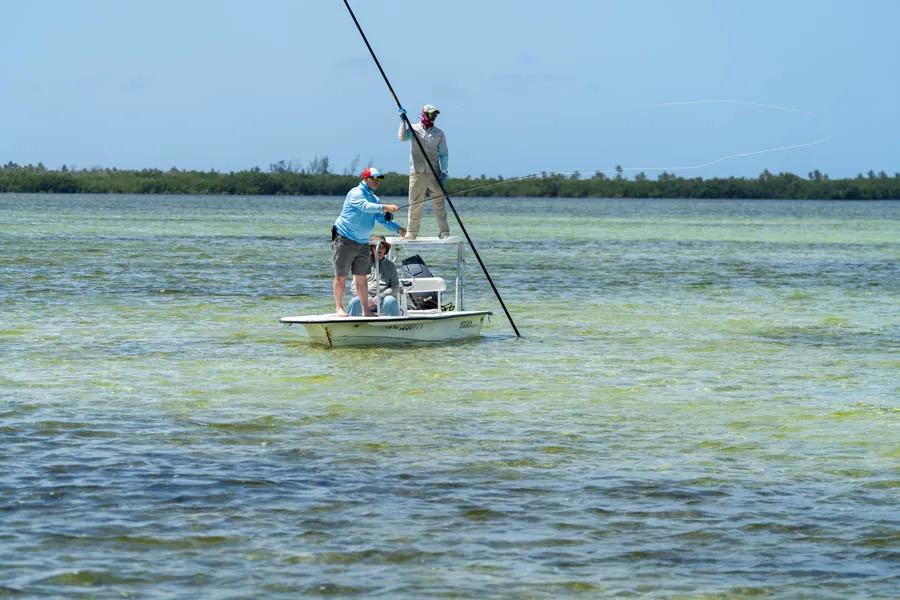
Permit
Cayo Largo also provides exceptional angling opportunities for permit. However, just like fishing for permit anywhere in the world, fly fishing for permit in Cuba requires a healthy amount of determination and patience because, well, they are still permit. As with bonefish, our opportunities for permit included everything from large schools to single big fish among the white sand and turtle grass flats. I paid close attention to any rays I could identify, as permit are often found trailing behind these rays to feast on the shrimp that are exposed by the passing ray. I had at shots at permit every day of the week and definitely fed my fly to several of these finicky fish, but hooking and landing a permit on the fly is the culmination of skill, luck, and being in the right place at the right time.
My first realistic shot arrived on Monday, our second day of fishing. My guide, Vera, saw the small school of six permit first, slowly cruising right to left about 80 feet off our bow. I spotted the lead permit as he polled the skiff closer to the school, and Vera gave me the order to send it; “11 o’clock, 50 feet!” I made what I considered to be a good cast, landing the spawning shrimp pattern about a meter in front of the targeted fish. So far so good. “Strip, strip…he’ s following…” Strip after strip, the permit followed, inspected, and seemed to seriously consider slurping my hook-laden crustacean imitation.
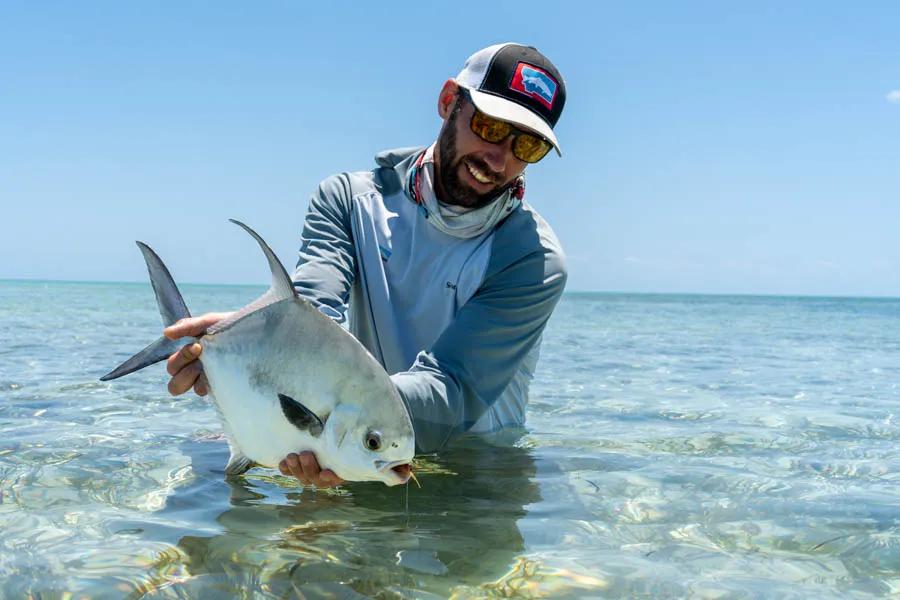
As it got closer to the skiff, we saw this was a very nice fish pushing the 20-pound mark. Unfortunately, I was running out of fly line and one last strip brought the loop to loop connection of my fly line and leader through the first guide of my 10 weight Helios with a subtle tick, and the school was gone. I finally exhaled, muttered a profanity or two, and looked back at Vera. “That was a nice one,” he said. "I know, Vera. I know," I said.
That’s the permit fishing game–when it all feels right, looks right, and should go right, the fish finds a way to hold serve. But, determination often pays off in the permit game.
It all came together for me on Thursday. After spending the morning hunting and landing several nice bonefish, Amauri, my guide for the day, and I decided to look for permit after lunch, taking advantage of the ideal light and calm winds. Less than 30 minutes after lunch, we spotted a small school of permit working their way in the general direction of our skiff. Before I knew it, Amauri gave me the “12 o’clock, 40’” call, and I dropped the fly just in front of the lead fish. A couple of strips and the entire school made a slow turn to the right and followed my fly nearly to the skiff before turning away. Not again, I thought to myself. Fortuitously the school, for no apparent reason, decided to make a u-turn and give me one more, even better, shot. “12:00 o’clock, 30 feet!” Another good cast. Three strips. Set. Permit was on! For a relatively small permit, this fish took off on two disc melting runs as I held my breath and prayed to every deity I could think of for the fish to stay on. Stay on it did, and I was able to land the handsome little permit.
With the bonefish and permit boxes both checked, it was a no-brainer to spend the rest of the afternoon searching for a tarpon to complete the Grand Slam. Within 30 minutes of releasing the permit we were able to check that box, too.
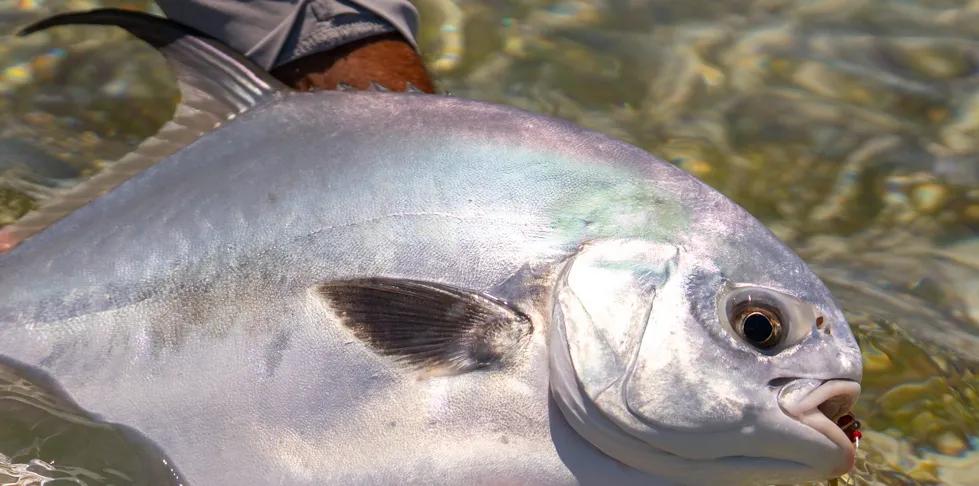
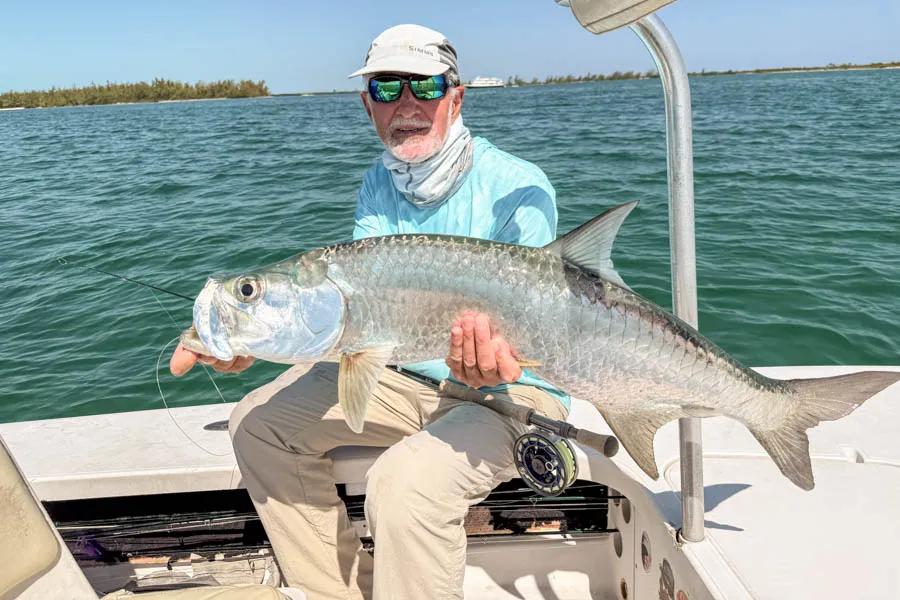
Tarpon
While the Cayo Largo area is best known, and accurately so, for being a wonderful bonefish and permit zone, it is also a reliable tarpon fishery. The guides out of Cayo Largo target mangroves, cuts, and the flats for medium-sized resident tarpon and during certain times of the year 100-pound plus migratory tarpon can be seen. Migratory tarpon and higher numbers of resident tarpon and larger migratory tarpon can also be found further west around Isla de Juventud, where Avalon also operates.
On Thursday–the day I caught my permit–while fishing with Amauri, I had tarpon on the brain with visions of a grand slam after landing several bonefish and a permit. Amauri had a few spots in mind as we ran from a beautiful permit flat to some juvenile tarpon-rich mangroves. We motored past a small school of several 10 pound-ish tarpon just protruding from some dense mangroves. We were motoring, so by the time we saw them, they had spooked and scattered. We doubled back for good measure, but to no avail. Amauri apologized profusely, explaining that he hadn’t seen them in that location lately, but knew better and should have killed the motor and polled through the section just in case.
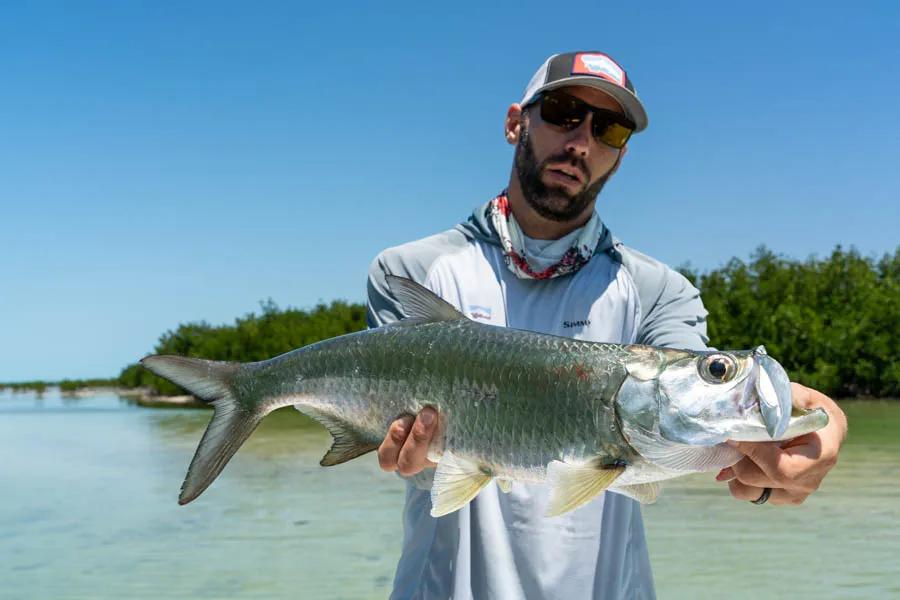
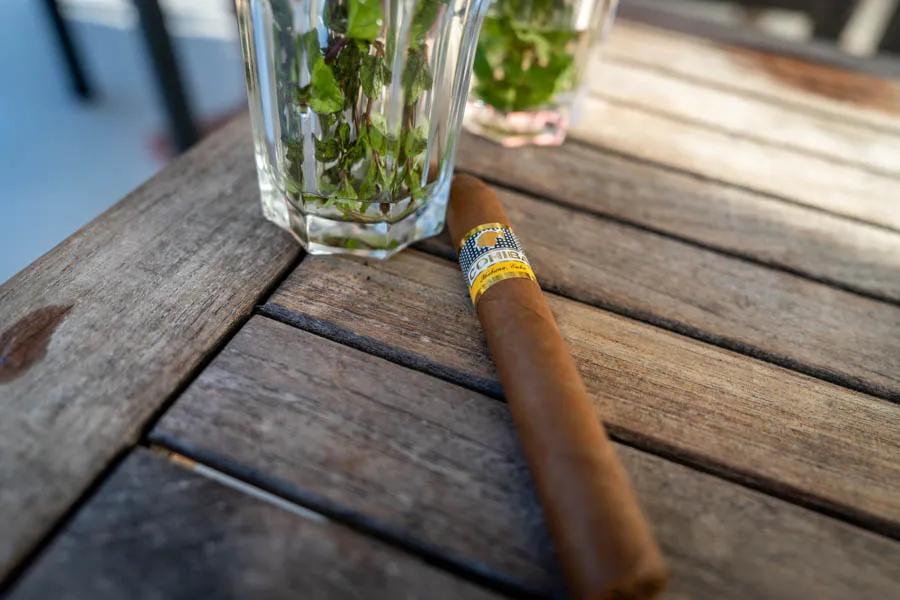
Of course, I now had to spend the rest of the afternoon looking for snook to complete the Super Slam. My best shot took place when a decent snook in the 10-pound range was lazily cruising in the shadows of some overhanging mangroves. I landed the black and purple peanut butter pattern just ahead of it and slowly stripped. The fish followed the fly excruciatingly slowly but followed it did. Just as it homed in on my fly and I was preparing to strip set, a tiny barracuda came out of nowhere and intercepted my fly, spoiling my shot for the super slam and adding insult to injury by stealing my fly to boot. Giving up on the snook and what would have been icing on the cake, I reeled in and headed back to the mothership to celebrate with a Cohiba and cold Mojito.
I could tell Amauri was now extra motivated to get me on a tarpon, and as we polled into a mangrove laden lagoon, we saw another school of about a dozen juvenile tarpon slowly swimming out of a small gap in the mangroves. Just as I let my initial cast go, the school had second thoughts and retreated back to cover. Amauri was confident they would reappear, and sure enough, they languidly swam back into range less than a minute later and gave me an easy 30 foot cast to land my chartreuse flashfire mushie pattern just off the nose of the largest fish in the school. An aggressive strike and multiple tail-walking displays ensued before I took full advantage of the 40-pound test to horse-in the fish and avoid any opportunities for it to throw the hook and spoil my grand slam shot. The small tarpon was quickly photographed and released and high fives were in order for a successful Thursday ‘slam.
Several anglers in our group also had the opportunity to hook and land tarpon over the course of the week. Even on the toughest weather day, I witnessed one of the anglers on the trip, Jim, hook a nice resident tarpon. We were fishing a deeper cut running off the beach as we were making some of the last casts of the day. I watched Jim set the hook and the tarpon immediately put on an impressive tail-walking display. As I grabbed my camera and got into position to try to get a picture, the tarpon tail-walked once more, spit the hook, and left Jim to wrestle with the mental anguish that tends to occur when a nice fish wins the battle.
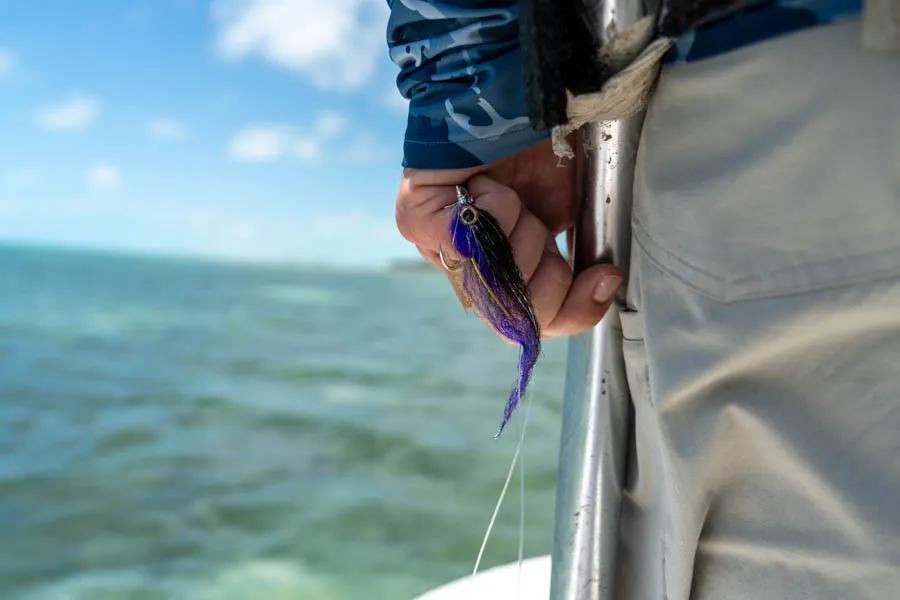
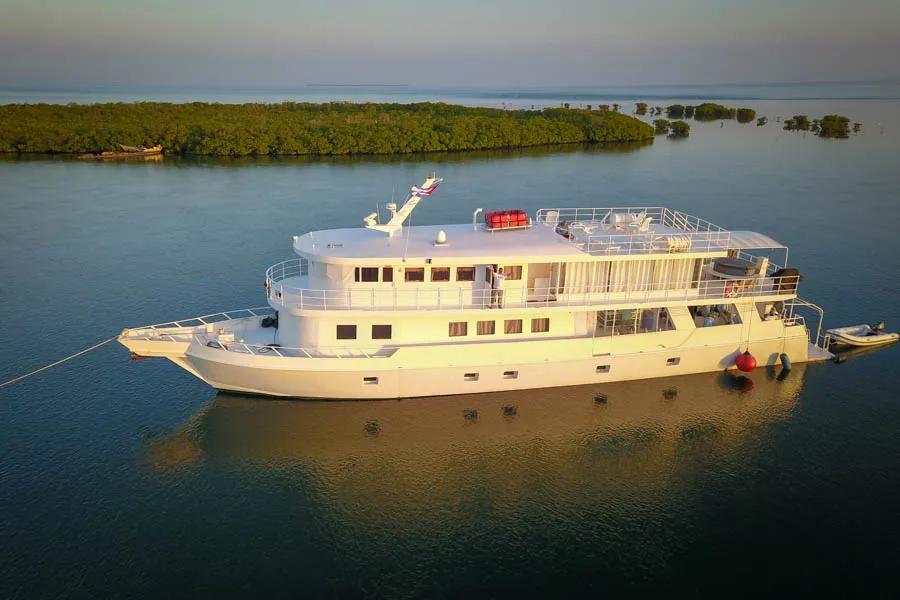
Accommodations
As with most operations operated by Avalon in Cuba our accommodations for the week were upon a liveaboard yacht. The 110’ JA1 provides 10 guest rooms, each with a private bathroom and individually controlled A/C. The three story liveaboard has several gathering areas including an air-conditioned living room, an air-conditioned dining room and bar, an outdoor sitting area with hot tub, and a sun deck. There is also an ample staging area with racks for 30+ rods and plenty of room for rigging.
The food onboard was excellent. Dinner each evening was served family style and guests could choose from a variety of offerings including fresh lobster and snapper ceviche. Wine and beer were complimentary, as were the Mojitos and Cuba Libres mixed up by the ship’s talented bartender, Davi, upon returning from fishing each afternoon.
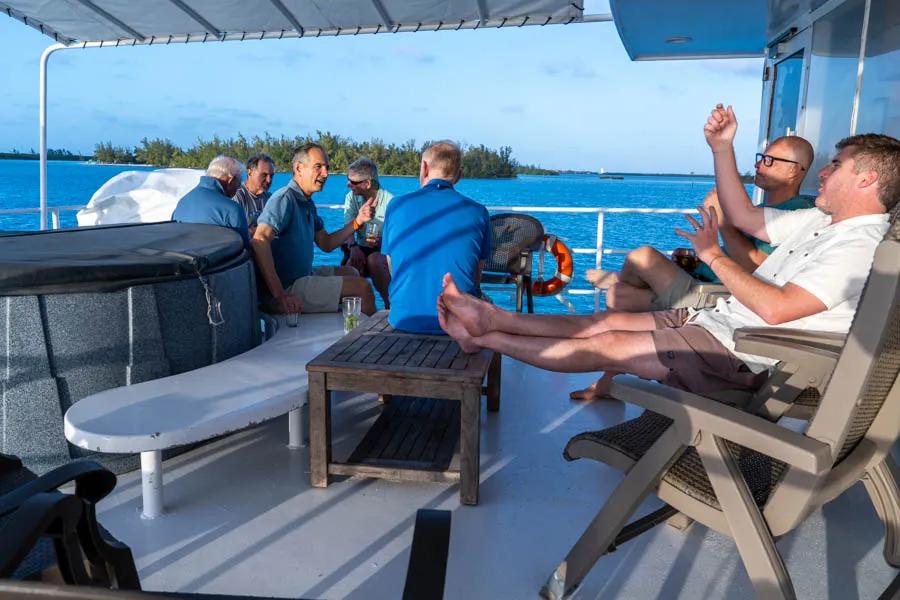
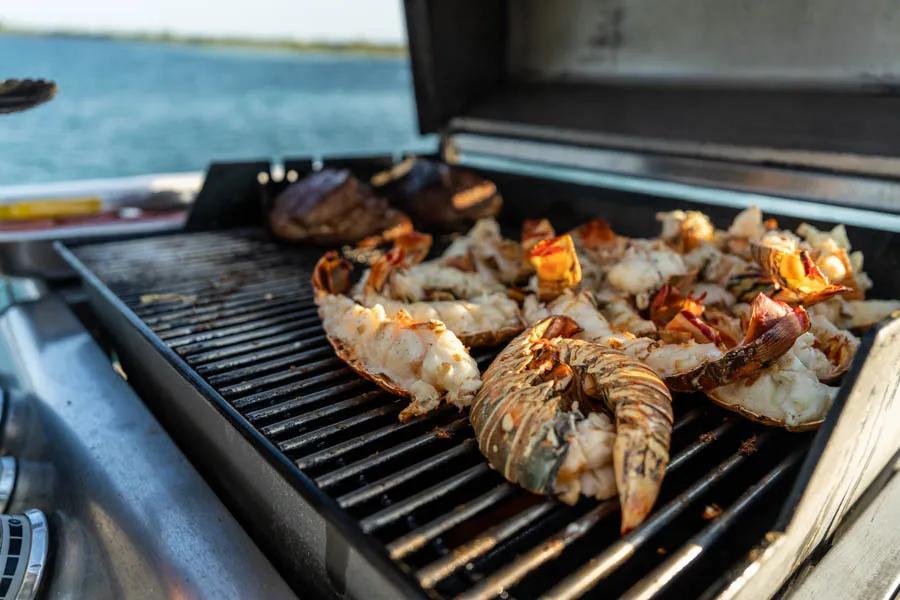
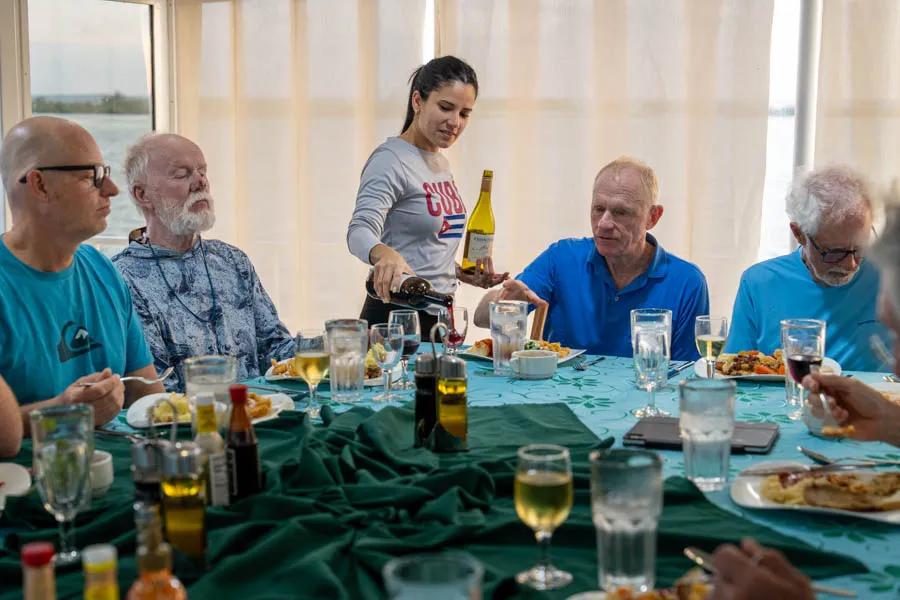
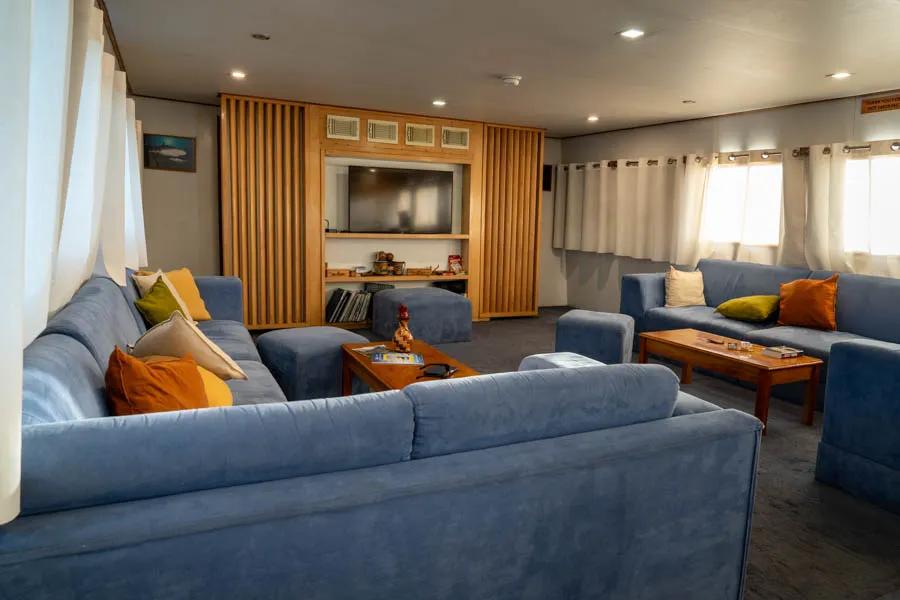
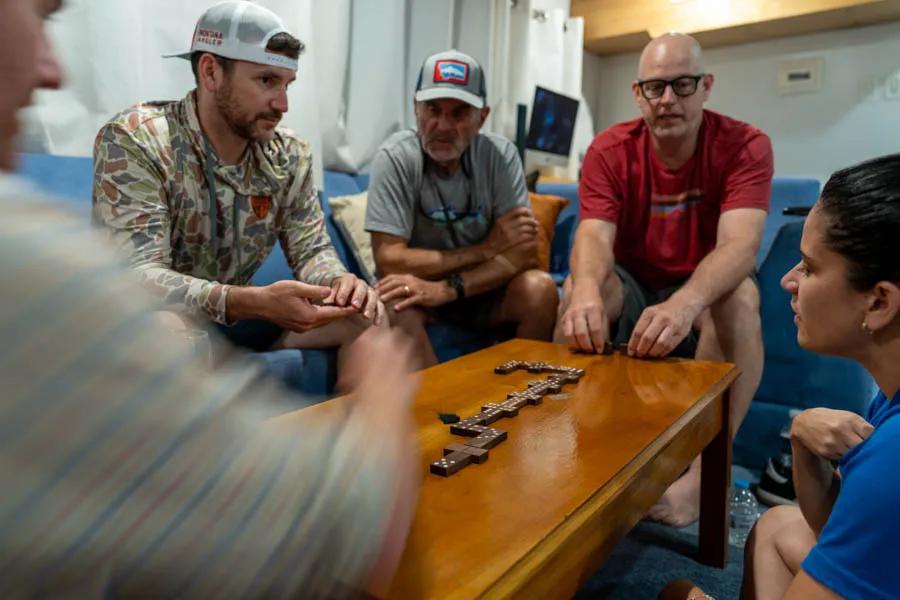
Travel Logistics and Havana
Most in our group chose to spend a couple of nights in Havana before heading to the mothership. Travel to and from Havana from the U.S. was surprisingly simple. There are several daily flights available on multiple U.S. carriers, and there are numerous qualifying exemptions for U.S. citizens to travel to Cuba legally, including a fly fishing trip to Cuba.
In order to enjoy Havana as well as ensure a buffer for any travel hiccups, we secured a large 12-bedroom Airbnb in Old Havana for Thursday and Friday nights. Our Airbnb host was incredibly helpful in giving us the lay of the land, arranging tours, and booking and arranging any local transportation needs. Our two days exploring Havana were fascinating and felt somewhat like traveling back in time. From the 17th century Spanish architecture, to the mid-20th century American automobiles, to the unreliable electrical grid, Havana is unlike any other city I have had the chance to visit.
Both in and out of the city, it is obvious that Cuba is a very poor country. Food, fuel, and general goods are strictly rationed by the government and those rations are often inadequate to meet the needs of the people. Despite these realities the positive attitudes and general friendliness displayed by the Cuban people I encountered was inspiring.
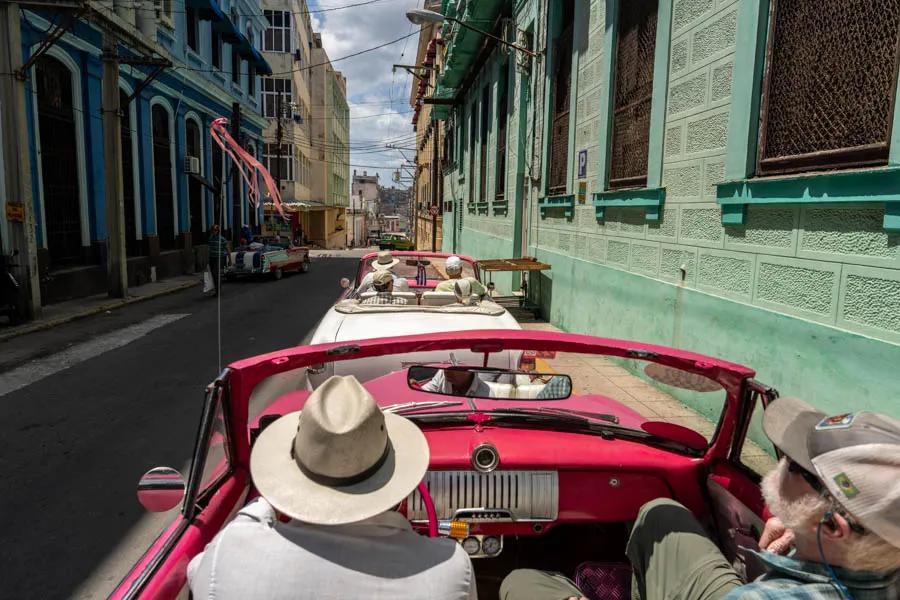
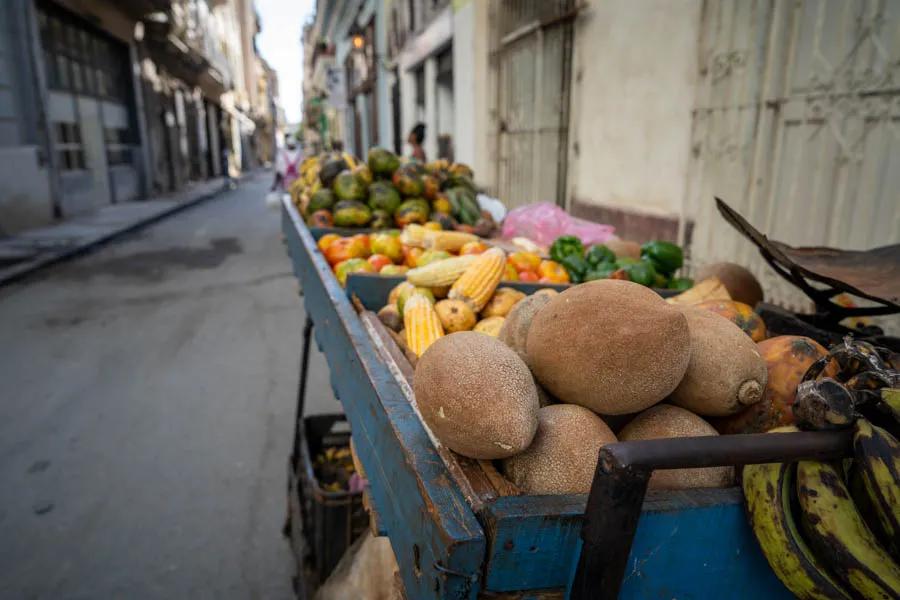
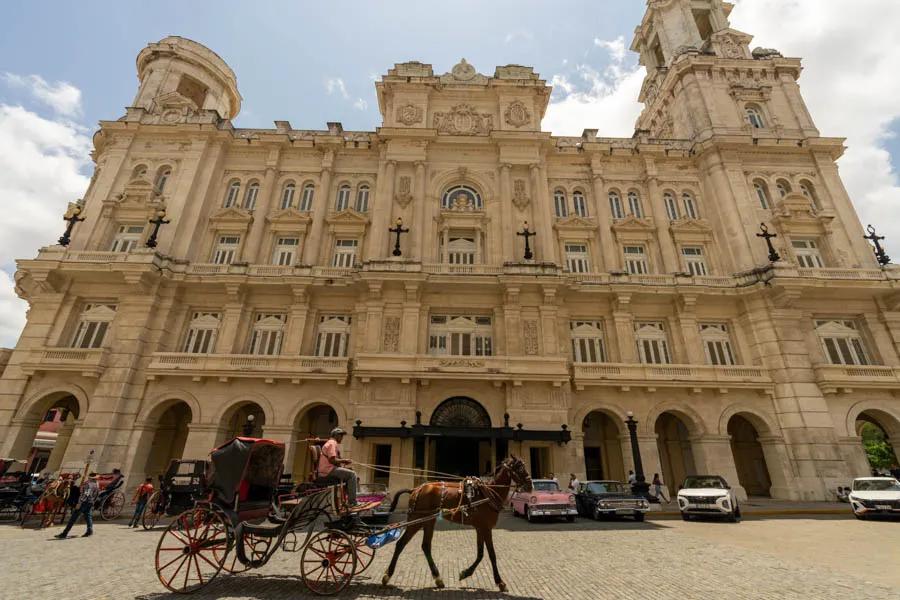
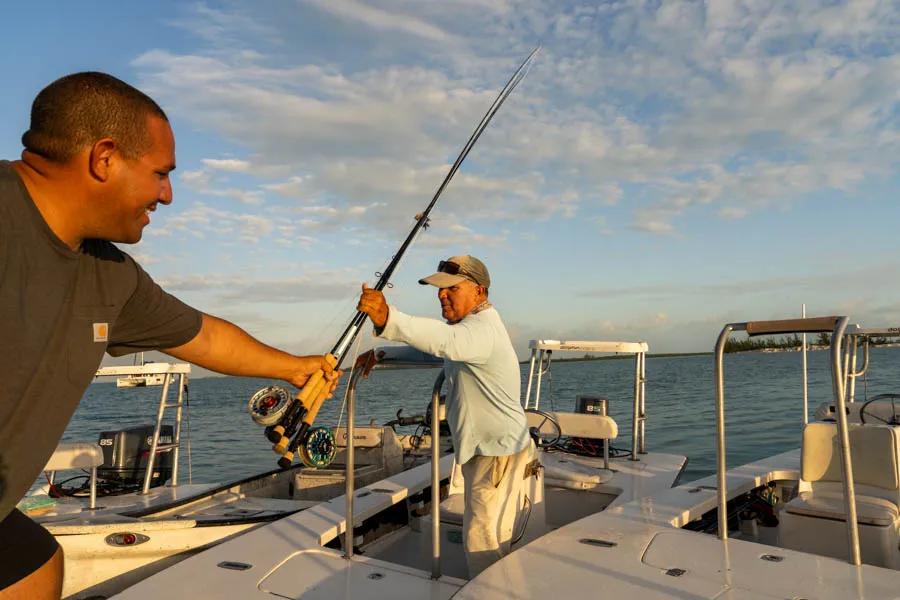
Gear and Equipment
There are no fly shops in Cuba so anglers need to arrive completely self-sufficient for the week. The wide variety of species targeted, and types of water fished call for an array of rods and patterns. Because on any given day any of the Big Three--bonefish, tarpon, and permit--can be encountered so it is important to prepare and pack appropriately. Each skiff should be prepared with:
Rods:
8 weight with floating line. Two of these so both anglers can chase bonefish at the same time when wade fishing.
9 weight with floating line. This is a great permit rod or can also be the preferred bonefish rod when the wind is strong.
10 weight with floating line. This is a great barracuda rod and can also be used for permit, especially if the wind is blowing. It also serves a nice tarpon rod for the small to medium sized resident tarpon.
11 weight (or maybe a second 10 weight). This is a nice tarpon rod and it is good to have both a floating line as well as a spool with sinking or intermediate line.
Flies:
An assortment of Bahamas style shrimp flies (Gotchas, mantis shrimp, spawning shrimp, etc). Size 4-8 with both chain eyes and some lead eyes. These are great for bonefish.
A few bigger size 2 shrimp for permit such as mantis shrimp, the Avalon fly, and squimps.
A few crab flies for permit for the reef side flats including strong arm and flexo crabs.
A variety of tarpon flies - your normal go-to patterns like tarpon toads, tarpon tapas, Black death, cockroaches etc.
Some general saltwater baitfish patterns in size 2 up to 3/0 including mushies, Deceivers and Clousers.
A few needlefish flies for barracuda.
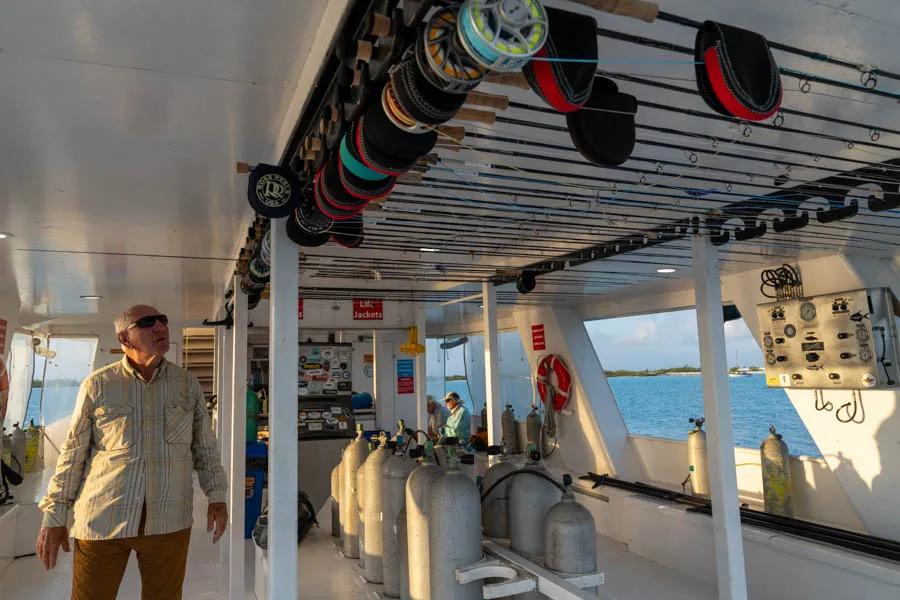
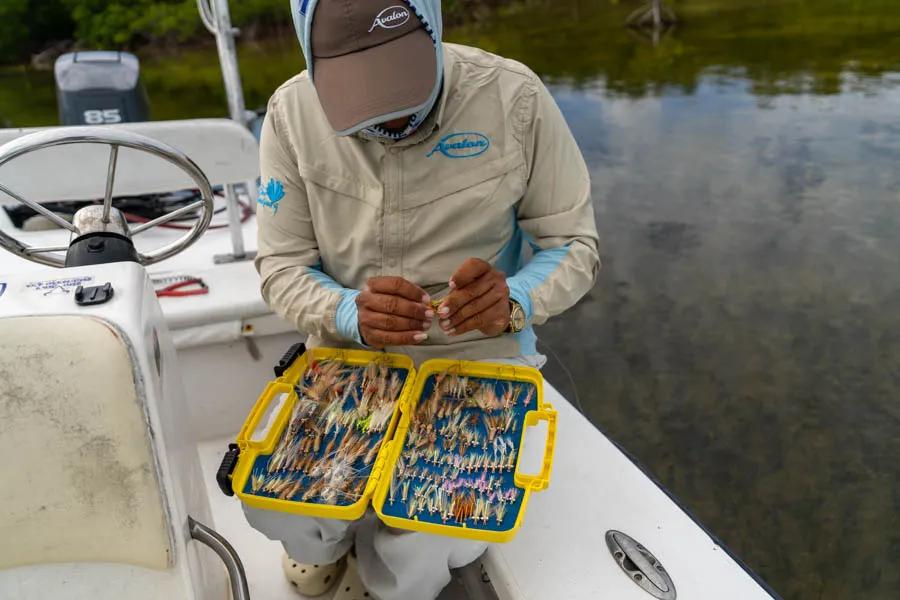
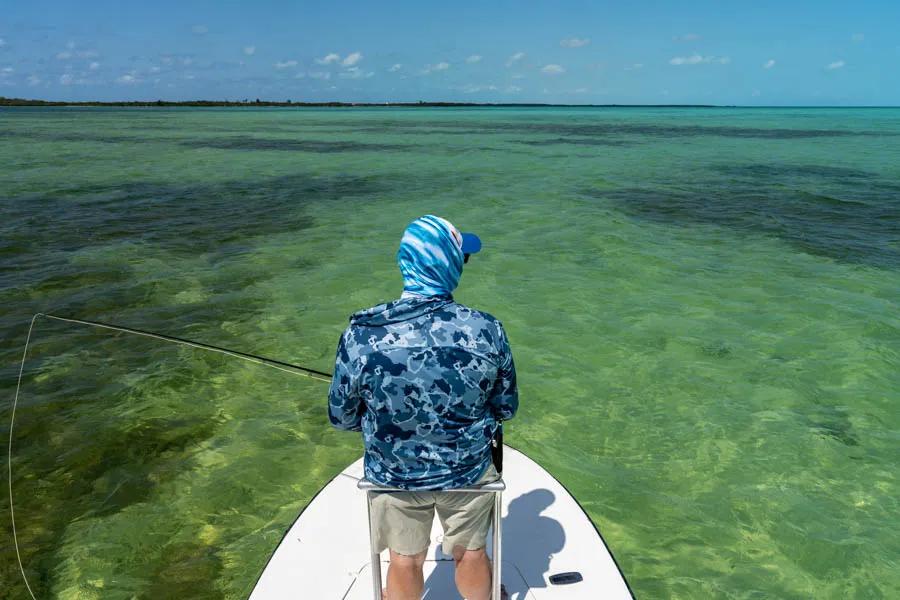
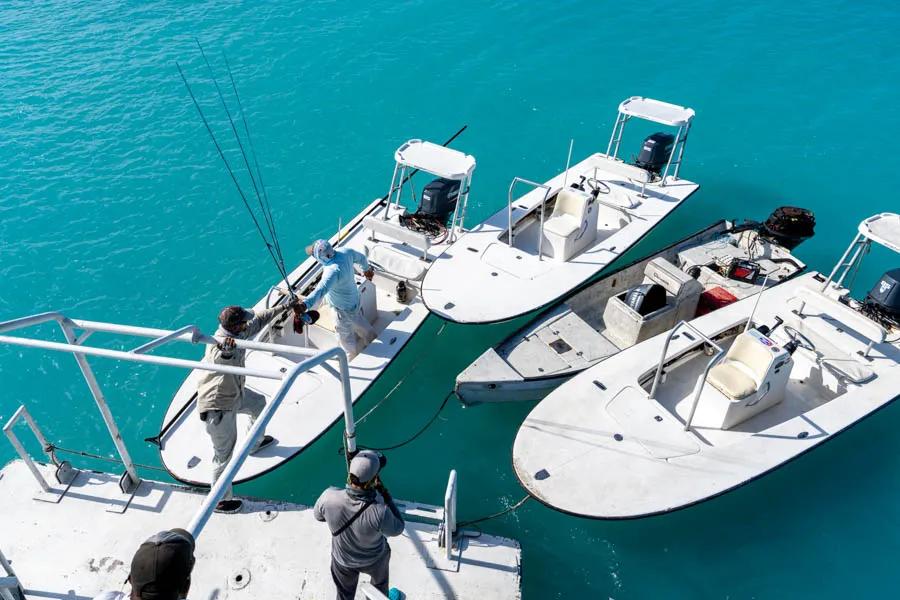
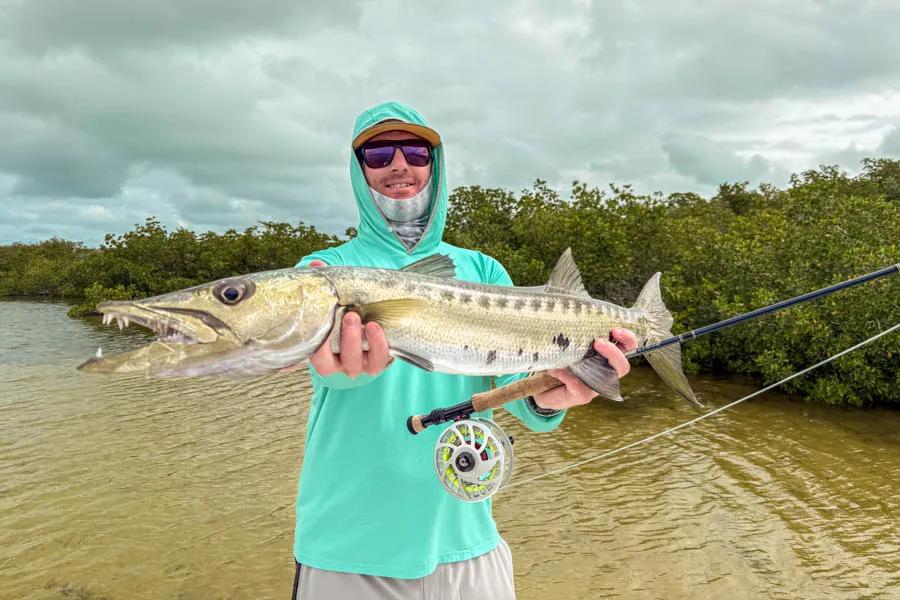
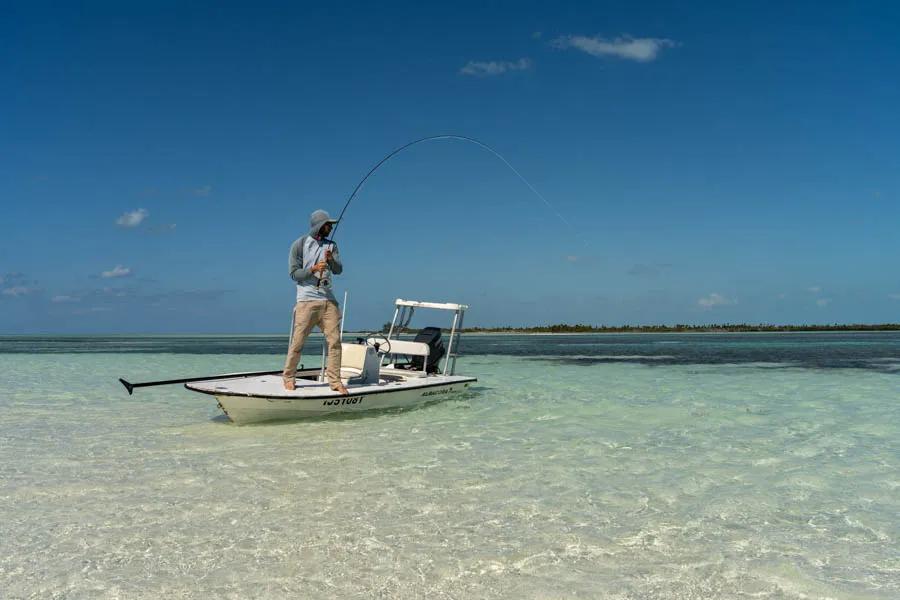
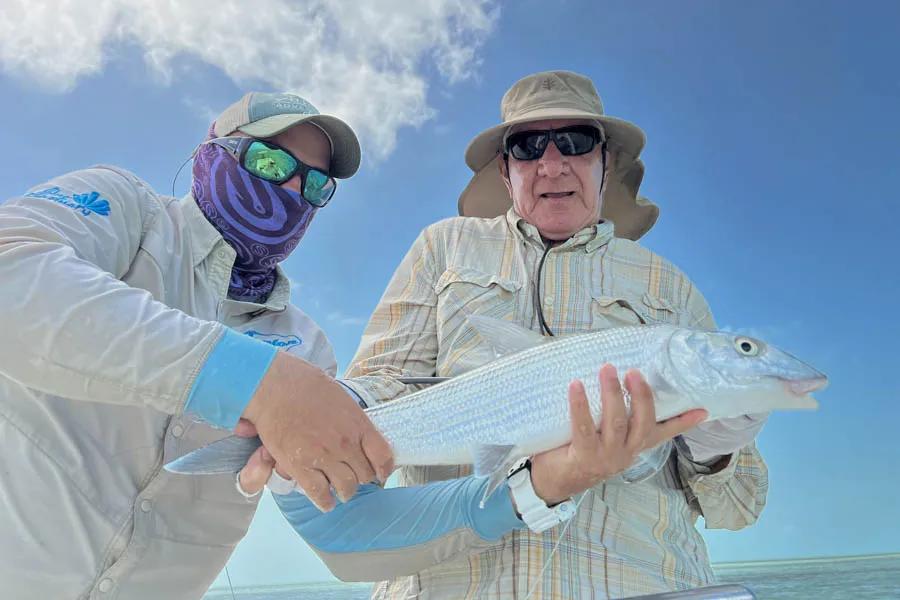
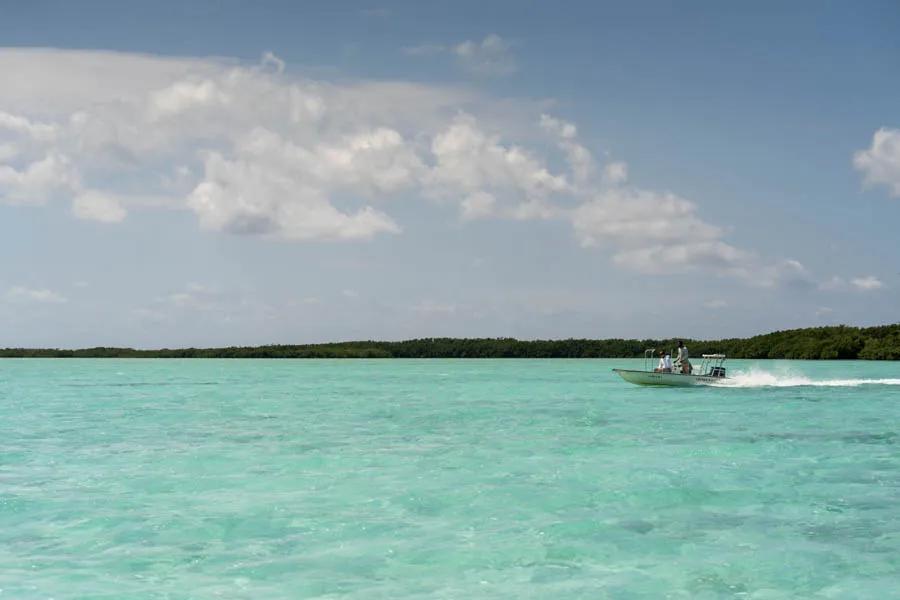
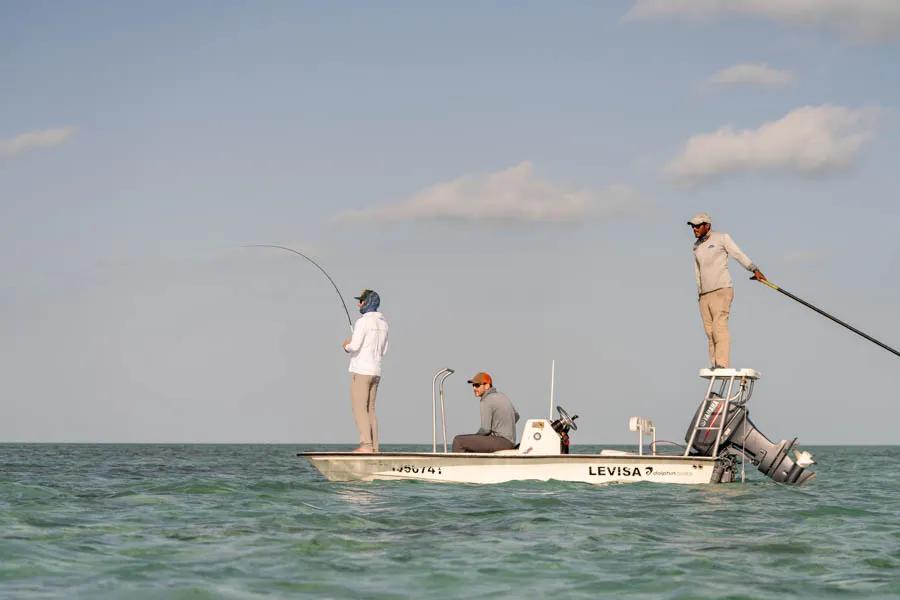
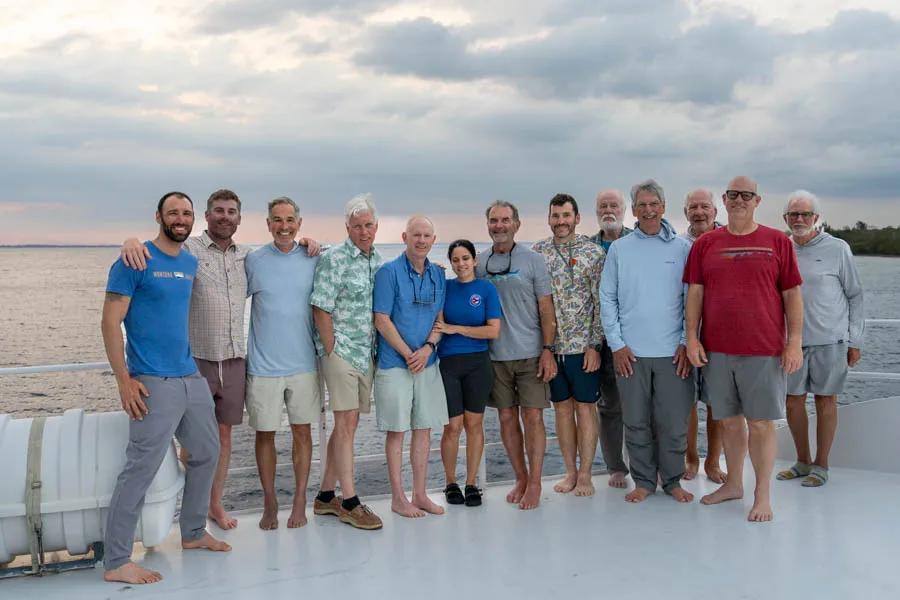
Conclusion
Montana Angler has returned to the Cayo Largo region each year due to its outstanding opportunities to fish for a variety of species, very limited angling pressure, comfortable accommodations, and excellent guides. The Cayo Largo area is undoubtedly an exceptional bonefishing location, and the presence of noteworthy numbers of permit and tarpon make it a bona fide, world-class, mixed species destination. The ability for the mothership to moor at several different locations throughout the week provides anglers the opportunity to fish new zones most days. The vast and varied fishery gives a lot of flexibility to respond to conditions such as weather and tides, providing access to both leeward and windward sides in addition to inter-island lagoons.
With so much water to fish, six days of fishing just wasn’t enough time to experience it all.
Fortunately, we are heading back in February of 2026 on another Montana Angler Hosted Trip with another hosted group and it can’t come soon enough! Reach out to Montana Angler today to learn about our exciting 2026 itinerary that includes a two-zone trip--fishing our partner has an exclusive permit for fishing the vast Cannareos and Cayo Largo Marine Parks in this vast archipelago south of the Cuban mainland. The Cannareos program encompasses the island chain between Isla de Juventud and the tip of Cayo Largo. The pristine flats environment is nearly the same now as it was hundreds of years ago. Our group will be limited to 11 anglers plus our Montana Angler host which means there will only be six skiffs in this massive region filled with small keys and sandy flats.
